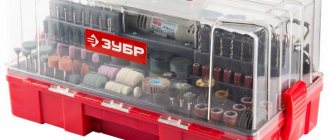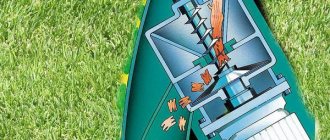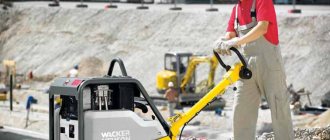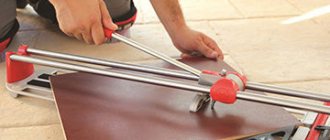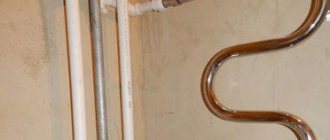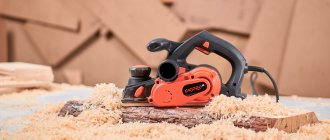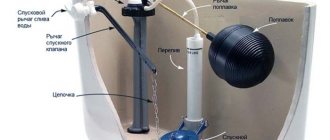- Water-cooled electric tile cutter: tips for choosing
- Electric tile cutter with water cooling: advantages
- Design and principle of operation of an electric water tile cutter
- Types of water-cooled tile cutters
- Electric tile saw DeWalt D24000
- Electric tile cutter BISON ZEP-800S: characteristics
- Table tile cutter Praktika Profi 1872
- Features of the tabletop tile cutter CORVET 460
- Electric tile cutter RUBI ND-180-BL Standard
- Which is better to buy an electric tile cutter with cooling: tips
- How to cut tiles with a water-cooled tile cutter?
- How to cut at an angle with a tile cutter: recommendations
- Video: electric tile cutter
Water-cooled electric tile cutter: tips for choosing
In order to cut tiles, there are special tools - tile cutters. The choice of this device directly depends on the intensity of its use. For fairly large volumes of work, it is customary to use an electric tile cutter with water cooling. This device allows you to process not only ceramics, but also porcelain stoneware. The article will discuss the main models and characteristics of such a product.
Tile cutter: types, characteristics, which one to choose (read more)
When carrying out large-scale repairs, when you need to cut a large amount of tiles or porcelain stoneware, it is necessary to use an electric tile cutter with water cooling.
Electric tile cutter with water cooling: advantages
Devices that belong to this group are highly efficient and have a long service life. The water supply system includes elements such as a hose and a reservoir with liquid. The pumping mechanism that draws water is activated simultaneously with the cutting element.
The water cooling system allows you to increase operating time without interruption, increases productivity, and increases the service life of equipment and cutting tools.
This cooling circuit achieves two main goals. First of all, it prevents the diamond blade from overheating. Equally important is that when cutting tiles with conventional mechanical devices, quite a lot of dust is generated. Using a water tile cutter allows you to cope with this problem, which makes the process of processing ceramic material more convenient. Dust captured by water particles immediately settles on the device.
Under the working surface for cutting tiles there is a special container, the height of which can be different. This depends on the water-cooled model. As a rule, this figure is no more than 10 cm. Dust and water flow down the blade, as a result of which it ends up in this reservoir. To ensure proper operation, it should be cleaned from time to time.
Mechanical manual devices (for example, Sigma tile cutters) require effort when working with tiles, and also do not protect from dust. In turn, electric tools cope with this task. They can also function offline. In this case, the hose delivering water is connected to a container that is placed under the working surface.
The movement of liquid in an electric unit is carried out in a closed cycle. This allows you to use a minimum amount of it to complete a large amount of work.
Using an electric tile cutter, you can give the tiles almost any shape, but do not forget that the price of such equipment is quite high.
Video: How to Use an Electric Tile Cutter
Do not forget to periodically replace the water in the tank, as all cutting products get into it. dust and large tile particles. They can contaminate the diamond blade and remove it, which in the worst case can damage the blade or tile. Damage to the disc while the tile cutter is turned on is dangerous from the point of view of injury to the worker. If you see that the disk is very dirty or worn out, you should replace it with a new one. In this case, you can make a neat and smooth cut.
And for the record, you can see a video on how to use an electric tile cutter using the PLE-200 900 gauge as an example.
Source
To cut ceramic tiles perfectly, use a handheld tile cutting tool in most cases. For the most part, you don't need to have professional skills to use it, so the tool can be used quite successfully at home.
A manual tile cutter has many positive aspects, including ease of use, which results in a very clean cut. The handle additionally also serves as a lever, which allows you to reduce the applied effort to a minimum.
At the same time, there were no negative moments without Bosch. For example, a handheld tile cutter should not be used very close to the edge of the tile (the acceptable working distance should be at least five millimeters).
READ How to cut flat slate
Before you start, you should carefully study how to use a manual tile cutter. If you have problems with this problem, then on our website you can find a video that shows all the details and nuances.
Design and principle of operation of an electric water tile cutter
The device traditionally has quite large dimensions. It is a stationary device and operates by connecting to the mains. To ensure maximum convenience when cutting tiles, its platform is located at a height of about 1 m. This allows the master to perform all the necessary manipulations while standing, maintaining a comfortable body position. The distance from the floor to the desktop can be adjusted depending on individual preferences.
From a design point of view, such devices have a certain similarity with circular saws. The device consists of several main elements, including: an electric motor, a cutting wheel, a working surface and a bed. This type of tile cutter is also equipped with an adjustment system for the functional part and special locking devices.
On a note! As a rule, a diamond disc is used as the main cutting element in such devices.
The cooling system functions quite simply and supplies liquid to the point of contact of the cutting device with the ceramic product. Thanks to the high quality of diamond blades for tile cutters, the devices can be used for processing various materials, such as porcelain stoneware, stone, concrete, glass, etc.
The water-cooled electric tile cutter has a diamond blade cooling system to ensure a longer service life.
Cutting tiles and porcelain tiles with a mechanical tile cutter
To properly cut tiles with a tile cutter, it is recommended to first keep them in water for some time - this makes it easier to cut.
Using a mechanical stationary tool, cut the tile material in the following way:
- a marking line is applied to the surface of the tile;
- lay the tiles on the bed so that the markings coincide with the trajectories along which the cutting wheel (carriage) moves;
- lightly pressing on the carriage, move it once along the cut line;
- the handle is placed in the working position, then it is sharply lowered, breaking the tile along the cut.
In order for the edges of the final pieces to be neat, the cutting line should be at least a centimeter from the tile edge.
The pressure on the carriage should be so strong that the wheel cuts through the tile enamel and the tile does not press through. It is not worth doing this several times, because the edges of the fragments will turn out uneven. When the edge turns out to be uneven and chipped, it will need additional sanding. It is possible to cut porcelain tiles with a stationary tile cutter only for tiles up to 15 mm thick. The process algorithm is completely similar to that described above.
Hand-held roller cutters work in the same way as stationary cutters. In this case, only tiles of minimal thickness are suitable: such tools are not intended for professional use. Some beginners quite often have the question of whether it is possible to cut glass with a tile cutter. This can be done, but only with ordinary material. To cut hardened varieties, you will need a special power tool.
Tile cutters and nippers work as follows:
- place the tool on the edge of the tile, placing its wide part on the front surface of the ceramic, and the central part of the nippers is placed along the bend line directly above the groove;
- then carefully break off pieces of material.
Using wire cutters you can make round holes, but to do the job well you need to have the appropriate skills and be careful.
Types of water-cooled tile cutters
Today there are a huge variety of models of these devices. They are produced by different brands and differ from each other not only in appearance, but also in technical characteristics.
All electronic tile cutters are usually divided into two main types:
- manual;
- professional.
Manual. Such tools have a simple and convenient design. They can operate both from the electrical network and from a rechargeable battery (AB). According to the principle of operation, they resemble angle grinders, with the only difference being that they use tiles as products for processing.
A manual electric tile cutter consists of a handle, a support element called a soleplate, and a fluid reservoir. As well as elements that allow you to adjust the position of the functional part. It is advisable to operate such a device only in a horizontal plane. This is due to the fact that, being in a vertical position, the product does not prevent the formation of dust. For more complex work, there are manual professional tile cutters.
A household electric tile cutter is not intended for cutting hard materials, such as porcelain tiles and granite; it can only work with tiles or glass.
Today on the construction market you can find larger models that run on battery power. The main advantage of such devices is autonomy. They are a kind of transitional link located between manual and professional instruments.
In turn, professional devices are classified according to characteristics such as the location of the motor. It can have two positions:
- above the working plane;
- below the working plane.
Devices with a motor at the bottom. The main characteristics of such models include high cutting quality, as well as good protection from dust during operation. The cutting element is represented by the same diamond-coated disk. The design feature of this device is the location of the functional part. The upper half of the cutting wheel is located above the working plane, and the lower half is placed in a reservoir of water.
This motor position allows the production of compact equipment that is versatile. Such devices are highly popular in the construction market precisely due to their small dimensions. When renovating an apartment, it is always difficult to find enough space for a large model.
A professional water-cooled tile cutter has sufficient power and performance, it is large in size and has a high price.
Bottom drive devices allow you to cut fairly large products from ceramics and other finishing materials. This is due to the fact that there are no limiting structural elements on the working surface.
On a note! Among the disadvantages of stationary models that have a motor at the bottom, it can be noted that during cutting you need to move the workpiece with your own hands. Therefore, it is advisable to have experience to work with such a tile cutter.
Models with motor on top. They are professional electric tile cutters. Devices of this type are quite large in size and have a complex design. To operate a water-cooled top-drive electric tile cutter, you must have sufficient experience.
All devices with a motor located at the top are divided into two types:
- console;
- pavements.
In the first case, the device is equipped with a console, which is secured using special locking elements. The working platform of such a device is characterized by mobility. Bridge electric tile cutters include a movable functional part that moves using special guide elements.
A more reliable and high-quality electric tile cutter with water cooling, the motor of which is located in the upper part of the tool.
Working with a tile cutter
How to lay tiles on the bathroom floor with your own hands
But it is still best to work with tiles using a special tool - a tile cutter. This tool can be used to cut gypsum and tiles; this method is also suitable for processing porcelain stoneware. Let's figure out how to cut tiles with a tile cutter.
There are two versions of this tool: manual and electric. The first option is small in productivity; it can be used to cut material up to 6 mm thick. Let's figure out how to use this tool correctly.
Manual option
The cutting process is quite simple; you can process a large number of tiles in a short time. The disadvantage is that it is impossible to cut a narrow strip of tile with this tool. In addition, the cutting line is not smooth enough; it has to be “refined” with sandpaper. Procedure:
- first, as usual, we carry out the markings, for this you can use a marker;
- then the element to be processed is placed on the base of the tile cutter so that the intended line is exactly under the surface of the cutting edge;
- Now you need to move the roller along the intended line. It is advisable to make only one pass, since repeated passes with the roller deteriorate the quality of the cut;
- Next, you need to press a special lever, and the tile will carefully break along the intended line.
Electric tile cutter
The most convenient way to cut any type of tile is to use an electric tile cutter. Cutting is done quickly, with this device you can cut narrow strips, and the cut is almost perfect.
Moreover, the tile cutter allows you to cut the material at an angle of 45 degrees, which is very convenient when laying tiles or porcelain tiles diagonally. The device consists of the following elements:
- electric motor;
- cutting disc with diamond coating;
- grounds.
During operation, the disc is cooled and lubricated by supplying liquid to it. This improves cutting quality and reduces dust. But when working with an electric tile cutter, the use of protective equipment is mandatory.
So, there are various tools for cutting tiles. The most convenient to use is a tile cutter. But this device is not cheap (especially its electric version), so it makes sense to purchase it if the master often works with tiles. To perform a one-time job, you can rent a tile cutter or use other tools.
Electric tile saw DeWalt D24000
This type of device is versatile. It can be used to cut ceramic or paving slabs. The device is also often used for stone processing. The design of the device includes two supporting elements, which not only increases the accuracy of the cut, but also allows it to be performed at an angle of 45°. To protect the cutting wheel, it is placed in a special casing.
A machine of this type is quite common in small enterprises. It is considered one of the best tile cutters and is capable of performing fairly large volumes of work.
The cutting accuracy in such a device is ensured using special guides. They are made of stainless steel, so they are resistant to corrosion. Using this machine allows you to make cuts up to 61 cm in length.
The water cooling system of this electronic tile cutter includes double water jet channels. If necessary, their operation can be adjusted so that the diamond blade receives the optimal amount of coolant. This type of device is also equipped with reservoirs for catching water droplets, which are located on the back and sides.
The DeWALT D24000 machine has two stops, which increases the accuracy of cuts and makes it possible to cut at an angle of 45 degrees without preliminary marking of the material.
This device operates from a network with a voltage of 220 V. Its power rating is 1600 watts. Spindle rotation speed – 4200 rpm. The device is quite bulky and weighs 32 kg. The price of an electric water-cooled tile cutter of this type averages 64,000 rubles.
On a note! The capabilities of the DeWalt D24000 are quite wide. In addition to the usual longitudinal cuts, this device is used to organize holes for sockets.
Electric tile cutter BISON ZEP-800S: characteristics
This device has good performance and includes an electric motor with a power rating of 800 watts. Like the previous model, this device is equipped with a water cooling system. All important elements of the machine, including the working surface of the table, are made of stainless steel.
This device can cut facing materials at different angles (from 0 to 90°). The maximum cutting length is 53.5 cm. The device operates from an electrical network with a standard voltage of 220 V. The motor in this electric tile cutter is located on top, so it belongs to the professional group.
BISON ZEP-800S is a fairly powerful electric tile cutter for cutting various types of ceramic facing, paving and floor tiles.
The rotation speed of the spindle element is 2950 rpm. The weight of such a device is approximately 30 kg. This device is quite common and has many positive reviews among consumers. The price of the electric tile cutter BISON ZEP-800S ranges from 11,000 to 13,000 rubles.
Table tile cutter Praktika Profi 1872
This device is desktop and allows you to process tiles quite quickly and accurately. The engine power rating of the unit is 72 watts. Among the features of the device, it can be noted that it allows you to cut facing materials without applying preliminary markings. This is achieved by parallel stop of the working plane.
This type of desktop model has compact dimensions, which allows you to move it without any effort. The unit is adapted for cutting products whose length does not exceed 30 cm. It operates from a conventional electrical network with a voltage of 220 V. The spindle rotation speed in this case reaches 2800 rpm.
This electric tile cutter is equipped with water cooling and has a special reservoir for liquid. It can be used to cut not only ceramic tiles, but also porcelain stoneware products.
The electric desktop tile cutter PRACTICA 1872 Pro includes a case that makes transporting the machine simple and convenient.
Practice Profi 1872 is small in size and weighs only 16.5 kg. The cutting depth of a desktop type device is slightly less than that of professional machines and is 20 mm in this case. How much does this type of tile cutter cost? You can purchase this unit for 7500-8000 rubles.
Features of the tabletop tile cutter CORVET 460
This unit has a lot of positive qualities, which is why it is popular in the construction market. First of all, it is worth noting its versatility. The device can be used for cutting not only ceramic, but also paving slabs. The cut can be performed in three positions: straight, at an angle, and combining the first two.
The electric tile cutter “Corvette 460” is designed for cutting all types of ceramic facing, floor and paving tiles with a diamond disc to size and is equipped with a fairly powerful asynchronous motor.
The device includes two stop options: parallel and angular. The motor of this water-cooled electric tile cutter is asynchronous. The spindle speed is 2850 rpm. A special casing is used to protect the diamond blade. The power rating of the device corresponds to its small volume and is 600 watts. This device operates from a network with a standard voltage of 200 V. It can cut cladding products up to 36 cm in length.
The approximate weight of the unit is 11-12 kg, which makes it convenient to transport and use. The average cost of this small-sized model is 4,300 rubles.
Advantages of a manual tile cutter
Compared to an electric tile cutter, a manual one has the following benefits:
- Low cost. It should also be noted that the cutting element is cheap: a diamond disc is much more expensive than a roller.
- Compact and light weight - easy to transport.
- Simplicity of design.
- Independence from electricity.
- No noise or dust.
- No running costs: When using the electric version you have to pay for electricity.
- Ability to work at any humidity and temperature.
Marking before cutting
Here's what it loses:
- Performance. For significant amounts of work, it is better to use an electric tile cutter.
- Cut quality. After using a manual tile cutter, the edge, if it is not hidden by the baseboard, has to be sanded.
- Difficulty performing the operation. A beginner will have to spend some, albeit short, time learning to move the roller with the same force and uniform speed.
- Possibility to cut tiles only in a straight line. A regular electric tile cutter also has this limitation, but there are special models for curved (shaped) cutting. The cutting element is a ring rotated by a motor.
- It is not possible to cut a groove in the tile.
- The width of the cut part cannot be less than 1 cm.
In addition, a manual tile cutter has difficulty cutting hard tiles.
Electric tile cutter RUBI ND-180-BL Standard
A device of this type has good technical characteristics and is used, as a rule, to perform a fairly large amount of work. The main advantage of the device is its noiselessness when working with facing materials.
On a note! With this model you can cut facing materials at an angle of 45°.
The main materials processed on this device are ceramic tiles and porcelain stoneware. Thanks to the rip fence, the unit is able to perform fairly accurate cuts.
Water-cooled electric tile cutter RUBI ND-180-BL Standard allows you to cut workpieces of any size due to the absence of design restrictions on the work table.
Equipped with a reservoir for cooling the diamond blade. It is powered by a mains voltage of 220 V. The maximum power of the device is 550 Watts. Thanks to its low weight (10 kg), it is easy to transport. The average price of a water tile cutter RUBI ND-180-BL is 6,900 rubles.
Main characteristics or how to choose
Having found out that you still need a tile cutter, you should understand the criteria for its selection. To do this, the following main technical parameters must be taken into account:
- Power - affects the ability to perform work not only in large volumes, but also on sawing materials of different thicknesses. Power affects performance, so it is recommended to choose units with an engine power of at least 1 kW
- Disk rotation speed - when working with tiles and other durable materials, a high rotation speed is not required, so all models often have an operating range from 3000 to 4500 rpm. Multifunctional models have a speed controller that allows you to set the appropriate frequency depending on the type of material being cut
- The diameter of the disc affects the depth of cut, or rather the thickness of the parts that can be cut. When cutting cables, this parameter is not as important as when processing porcelain stoneware and other durable and thick materials. Depending on the model, the diameters of the disk have different sizes, but on average, the devices provide cutting workpieces with a thickness of 2 cm to 11 cm. When processing workpieces at an angle, the thickness decreases accordingly. When working only with tiles and tiles, there is no need to buy a machine with a large disc diameter, and vice versa, if you plan to process granite and marble, as well as concrete, then you will need to buy a device with the appropriate cutting wheel size
- Availability of auxiliary options and additional protective devices. Their presence makes the equipment even more expensive, but at the same time multifunctional and durable. Among the main options, it should be noted - overload protection, rotation speed regulator, function for setting the angle of the disk, motor overload indicator, protection against accidental start, turning off the motor when the water in the tank runs out, indication of a small amount of water in the tank, backlight, etc.
When choosing, it is important to take into account manufacturing companies, since not many modern construction companies produce devices. Those who produce water-cooled electric tile cutters include:
- Fubag from Germany
- Caliber - China and Russia
- Ryobi - Japan
- Makita - Japan
- Practice – Russia
- Assault - China
Choosing a professional tool requires a competent approach, which will increase the speed and improve the quality of preparing material for work. There are different types of water cooling on the equipment in question, so it’s worth learning about this in more detail.
Which is better to buy an electric tile cutter with cooling: tips
First of all, it is recommended to determine the purpose of the unit. Its cost and further nuances of choice will depend on this. If you want to purchase a device for one-time use, then it is best to buy a manual mechanical model. Electronic devices are more expensive, however, due to their characteristics they have many advantages.
Which is the best professional tile cutter to buy? Let's consider what factors you need to pay attention to when choosing such a unit:
Electrical parameters. Before purchasing a device, experts recommend finding out what voltage is required for its operation. As a rule, at home it is not possible to use models that require an indicator higher than 220 V.
The second important selection criterion, which also relates to electronic parameters, is power. To work with thick ceramic tiles or any other material, you will need to use a more productive device. The minimum engine power of such a unit must be at least 1500 watts. Such models are equipped with special diamond discs with a diameter of 35 cm (to increase the cutting depth).
The choice of a water-cooled electric tile cutter model is made depending on the specifics of the work.
If you need a device for processing ceramic tiles of medium thickness, then its power should be from 800 to 1400 watts. In this case, the diamond wheel will have a diameter of 25 cm. Less powerful devices are also suitable for cutting standard ceramic tiles.
If necessary, you can buy a water-cooled electric tile cutter that includes a safety system. Some manual models have a mechanism that prevents unintentional starting. In practice, it looks quite simple: two buttons that must be pressed simultaneously for the unit to start working.
On a note! Before buying a water tile cutter, carefully inspect the insulation of live elements. It is also worth considering that some units require grounding.
Desktop settings. The cutting depth is selected depending on the thickness of the tile. It is advisable to select a model that takes into account the regulation of the cutting disc. The table in some models, in which the motor is located at the bottom, tends to tilt. This is necessary in order to process facing products at a certain angle.
To work with heavy materials, the strength of the frame is important, which determines the total weight of the electric machine.
Experts advise paying attention to the quality of the unit’s base (frame). It must be made of durable, corrosion-resistant material. The dimensions of the working plane determine what size tiles can be cut on it. The surface of a good electric tile cutter should have a size of at least 60x45 cm.
Water supply parameters. Devices in which the engine is located below are equipped with a reservoir located under the working surface. Part of the cutting wheel is constantly in it during operation and is thus cooled. Experts recommend choosing a model with a medium-sized container.
Units with overhead engines have a more complex cooling system. In this case, water from the container flows to the cutting part through a pump. Before buying a professional water-cooled electric tile cutter, it is advisable to pay attention to the presence of filters for cleaning the liquid. They are not present everywhere. The power of the pumping device and other parameters of the water circuit are usually indicated in the relevant documentation.
When choosing tile cutting machines, you need to pay attention to the availability of adjustment of the cutting parameters and the location of the plate, as well as additional protection of the motor from overload and overheating.
How to use hand tools and cut tiles correctly
Before starting work, before using a tile cutter, you need to carry out a set of preparatory measures that will allow you to make a high-quality cut of ceramic tiles.
Preparing hand tools for work
First of all, you need to understand whether the device is ready to make a cut.
The preparatory process includes the following:
- Inspect the tool for defects. Particular attention should be paid to the roller - it should not have nicks or bends.
- The unit must be cleaned before each use, remembering to remove dirt from the guide and frame.
- Nuts and bolts need to be tightened. But you must not apply excessive force, otherwise you may break the thread.
- If there are noticeable problems with the movement of the carriage, it needs to be lubricated with oil.
Marking
Before using a tile cutter, you need to mark the fault line with a marker. The unit itself must be fixed so that the sharp cutting element passes along the intended line.
Determining the marking line will avoid uneven cutting of the material
Tile cutting technology
So, how to use a tile cutter correctly? For a high-quality and accurate cut, you should follow the following technology:
- For 1-1.5 hours, the tile material must be soaked in water or covered with a wet cloth.
- Fixation. Construction stores sell cutters that have a clamp, which allows you to make the die motionless. If such an element is missing, then the worker will need to support the material with one hand and work with the other. It is important to place the cutting element itself along the fault line. If the die is large, then any material can be placed under its edges to make it stable.
- The cutter should be on the drawn line.
- During the work, you will need to put in extra effort to make it easier to break the die into pieces later.
Important! If the furrow turns out to be shallow, then there is no need to go over it with the tool again, since the edges may turn out sloppy.
Straight cut
How to use a tile cutter to make a straight cut? Here you need to do this:
- The tile must be placed on the surface of the platform and measures must be taken to fix it. It is important that the marking line coincides with the central axis of the bed.
- Next, you need to perform a zero cut - lightly pressing the workpiece wheel, check whether the direction of movement of the roller coincides with the marking line.
- After checking, the cutter must be positioned on the edge of the finishing material.
- Having completed it from above, move the carriage away from you from the beginning to the end of the workpiece.
- Move the foot to the middle of the ceramic and press the handle with a sharp movement - this will cause the tile to split.
It is strictly forbidden to operate the device if a malfunction of the roller is detected.
Cutting off small parts
Using a tool, for example, a Matrix or Ddexter brand, you can split the part at a distance of 10-20 mm from the edge. For smaller sizes, you need to learn how to use the tile cutter-nipper device:
- The workpiece is installed.
- A support strip must be installed on the surface of the tile along the marking line.
- You need to use a roller to draw a groove.
- Next, with smooth movements you need to break off pieces of ceramic tiles using the jaws of the pliers. The sharp edges formed after cutting are eliminated with an abrasive stone or spatula.
When using the device, in some cases it is necessary to use auxiliary tools, for example, forceps
Curvilinear cut
Some devices are equipped with a “ballerina” - a circular drill with which holes are made.
How to use a tile cutter for this type of work? The process of making a curved cut:
- Markings are made using a ruler, compass and pencil.
- The workpiece is installed on the bed, and its center should be located on the main axis of the platform.
- The “ballerina” is brought in, the main rod is placed in the central part of the circle being performed.
- The circle line is lubricated with a small amount of oil, and the cut itself is carried out by rotating the handle.
- The center drill coming out means that you need to turn the ceramic over and drill from the other side.
Important! To make the cut textured, uneven edges are processed with a grinding tool.
It is allowed to start work only wearing protective equipment
Figured carving
If the ceramics must bypass communications, for example, a sink or toilet, shaped cutting is performed. This type of cutting is mainly carried out using a glass cutter or grinder.
The technology involves making straight cuts and breaking off pieces with special construction pliers. At the end of the work, the side of the cut must be processed with a grinder or a needle file.
Fault
At the end of cutting, you need to gently press the lever. The ceramic should break exactly along the intended line.
How to cut tiles with a water-cooled tile cutter?
Cutting tiles is a serious process, so before starting work, it is recommended that you familiarize yourself with some of the nuances. All electronic units that include a water circuit have a certain sequence for cutting facing materials.
The functional part of water tile cutters is represented by a diamond wheel. The use of such a cutting element allows you to quickly and accurately perform fairly large volumes of work. When cutting, you must remember that the facing product must be moved towards the disc.
On a note! What material the tiles are made of plays a big role. The stronger the structure of the product, the more pressure must be applied to it during cutting. Experts recommend gradually increasing the pressure during work.
In order to avoid jamming of the cutting disc and minimize the percentage of vibration, it must be fixed on the table. The water that accumulates in the tank during operation gradually becomes contaminated, so it is necessary to change it on time.
It is best to apply pressure on the workpiece from both sides. This will eliminate the possibility of warping and chipping. In some cases, the diamond wheel may jam. Moreover, this does not depend on the cost of the unit and its quality.
During the cutting process, you need to press on the tile with a certain force, it will depend on its composition, thickness and density.
And, of course, do not forget about basic precautions when working with such a tool. Safety precautions include the use of special glasses to protect the eyes, as well as headphones from noise.
Tips for cutting tiles
The main thing is to get good at it, after which you will be able to cut tiles quickly and evenly, with virtually no defects. The correct choice of tool also plays a big role. You can read about choosing a tile cutter in our blog.
What tools are used for cutting
The full list of tools used for cutting and drilling porcelain stoneware includes manual or electric devices.
How to cut porcelain tiles without chipping
To avoid chipping on the front surface of porcelain tiles when cutting them, you must follow two rules:
- Cutting begins from the front side, since chips are most likely when the tool comes out of the material.
- When using a power tool with a cutting disc, the rotation speed of the latter at the beginning and end of the operation is slowed down.
- mark the cutting line;
- place the tile on the platform;
- make sure that the beginning of the marking coincides with the cutting edge of the disk;
- start the tile cutter;
- Holding the tile with both hands so that it does not deviate from its original position, cut the tile.
How to cut tiles with an electric tile cutter
In every way the best way to cut any type of tile. An electric tile cutter can quickly cope with a significant amount of work and leaves an even, high-quality cut. Cutting tiles at 45 degrees is quite a trivial task for him.
There are two main types of design. In one of them, the cutting wheel is fixedly fixed, and the platform can be moved towards the circular disk.
Or vice versa, the base platform is stationary, and the blade moves along guides that are located above the platform. The diamond-coated cutting wheel is partially immersed in a bath of water, or the liquid can be applied directly to the cutting site.
Thanks to this, the cutting surface is cooled, and the cut remains smooth and even.
Brief instructions on how to properly cut tiles with a tile cutter:
One of its advantages is that it allows you to cut thin strips less than 5 mm wide. But it has only one drawback - a fairly high cost.
READ High-current 18650 batteries for screwdrivers which are better
Tile cutter device
A cutting line is marked on the fixed tile, along which the tile cutter wheel is drawn. Next, the lever is lowered and the material breaks along the marked line. This work takes no more than 1 minute.
Rules for using a manual tile cutter:
- Before you begin the process, you should first try making a few experimental cuts of the desired curve. If you are unable to make the necessary cut with a manual tile cutter, you should use an automatic one, or make several cuts and break off the tiles in small pieces using nippers.
- How to cut tiles using a glass cutter and a nail
As a last resort, a nail and a glass cutter are used for these purposes.
Using a glass cutter, a notch is made on the front side of the material, the tile is laid on the nail with the back side so that the line made and the nail coincide, and then with your fingers you press on both halves of the slab. - You can also use a jigsaw with a carbide blade on it. However, it will take much longer to complete the work this way. But none of the above tools will do the job better than the tile cutter itself.
There is a category of tiles that, even with a thickness of 6 mm, are quite easy to cut. The higher the density of the material, the easier it is to work with.
Working with an angle grinder
The technology for cutting porcelain stoneware differs little from cutting other materials.
- Markings are applied to the tile with a pencil along which the cut will be made;
Using a grinder you can make shaped cuts and even holes
- The tiles are cut along the intended mowing line with a grinder. To reduce the number of chips, try to cut the tiles “in one go”;
- Since when cutting porcelain stoneware with a grinder, small chips and cracks may remain on the edges and front side of the tile, the end of the tile after cutting is cleaned with sandpaper or a grinding disc.
Sources:
https://remkasam.ru/kak-pravilno-rezat-kafelnyu-plitky-keramogranit-mehanicheskim-i-elektricheskim-plitkorezom.html
How to cut at an angle with a tile cutter: recommendations
Processing facing materials at right angles is not very difficult. Cutting tiles diagonally causes more problems and questions (especially for novice craftsmen). It is worth immediately noting that manual models are not suitable for such operations, so you will need to use an electronic unit with a water circuit.
Changing the angle in such devices is done by changing the position of the cutting head. Special screws are used to fix it.
Depending on what angles of inclination can be used when working with tiles, all electric tile cutters are divided into three types:
- cutting only at right angles (90°);
- allowing you to process tiles at two fixed angles (90 and 45°);
- operating in the range from 45 to 90°.
The dimensions of the working plane make it possible to cut tiles not only of standard sizes (30x30 cm), but also products whose length and width reach 1 m. A long table is one of the characteristic features of a professional tile cutter. However, different models differ from each other and, first of all, you need to look at their performance characteristics.
Almost all models of electric tile cutters can cut tiles and porcelain stoneware at an angle of up to 45 degrees, but you need to select your own blade for different materials.
When cutting tiles diagonally, you must be very careful to eliminate the possibility of chipping. Experts do not recommend putting too much pressure on the facing product when processing it.
Thus, there are several types of electronic tile cutters, each of which is selected depending on its purpose. When choosing this device, you should pay attention to its external elements. They must not be damaged. It is also recommended to study the passport of the electric tile cutter. Reviews about different models can be easily found on the Internet on specialized forums.
